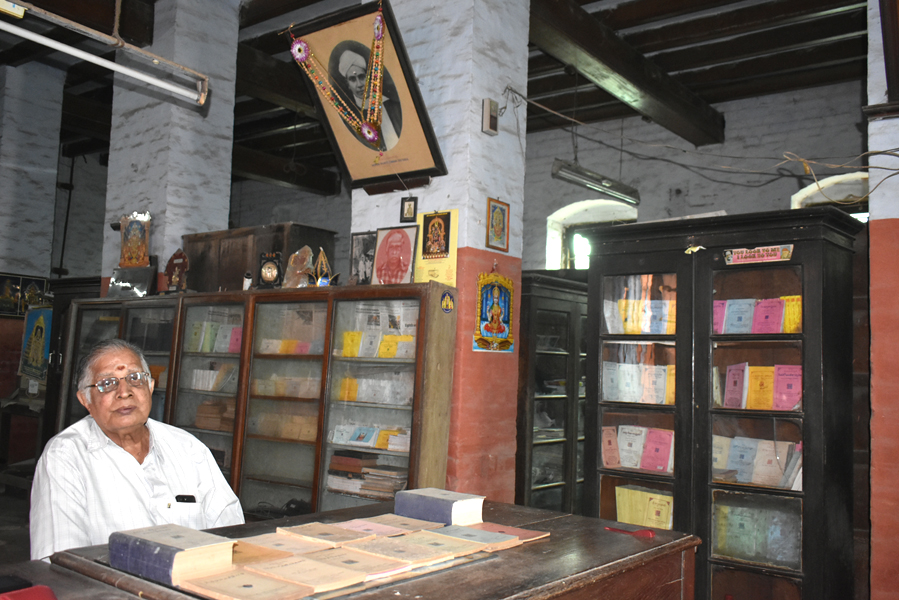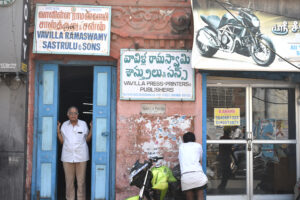Registered with the Registrar of Newspapers for India under R.N.I 53640/91
Vol. XXX No. 23, April 1-15, 2021
The forgotten pages – Vavilla Press
by Nivedita Louis

Alladi Srinivasamurthy with his works on display.
The quaint red building at Ramanujam Street in Old Washermanpet is a rarity. Hundreds of vehicles pass through the street, paying little attention to the Indo-Saracenic beauty almost clouded by the dust rising from traffic. To the eyes of a trained heritage enthusiast however, the little red building is like a bright flag waving for attention, tempting one to drop in and explore it’s mysteries. The plaque outside reads “Vavilla Press-1856” and I can’t help but race in. The little red building shines within, lit by a couple of tube lights that flicker. Rows of books stacked in antique wooden shelves greet me. A lone man sits at the centre table reading a newspaper. He pauses to welcome me inside, introducing himself as Alladi Srinivasamurthy.
The name Alladi immediately strikes a chord. The most famed of the Alladis was the former Advocate General Sir Alladi Krishnaswamy Iyer. When I ask if he is related to the great man, he replies in the affirmative. “A distant relative”, he says. He begins talking about the journey of the Alladi and Vavilla families as they made their way to Chennai from Andhra Pradesh. His fascinating narration pulls me into a time warp.

The exterior of the Vavilla Press.
Vavilla is a tiny hamlet near Nellore in erstwhile Madras Presidency. Ramaswamy Sastrulu left Vavilla in search of greener pastures. He arrived in Madras and settled in Tondiarpet with his family. He first tried his hand at the business of printing in 1854. By 1856, he had saved enough to establish his own press in Tondiarpet and named it “Vavilla Press”. The area comprised two and a half grounds. A striking Indo-Saracenic building rose in its place, where books were printed in English, Tamil, Sanskrit and Telugu.
Ramaswamy Sastrulu sparked a movement in printing and his son Vavilla Venkateswara Sastrulu upped the ante. With three printing machines, two typecasting machines, ten hand composing machines, as well as paper and board cutting machines, Vavilla saw tremendous growth under him. For someone who had lost his father at the young age of seven, Venkateswara was remarkably industrious, hard-working and sincere in carrying forward his father’s dream. On completing his graduation, he plunged into his father’s profession almost immediately. A fresher himself, Venkateswara could gauge the growing need to disperse knowledge. He had chosen his target audience already – the newly educated society that was thirsty to read. He planned to print grammar texts, literature and poetry that would be in continuous demand.
Vavilla printed epics like the Mahabharata, Ramayana and Bhagavad Gita, as well as their commentaries; it also brought out a Tamil translation Adi Shankara’s Soundarya Lahari. Venkateswara also meticulously published a variety of ancient Sangam Tamil grammar texts such as the Tholkappiyam with Ilampooranar’s commentary, Puraporul Venbamalai written by Aiyanarithanar, Vetriverkai poetry and it’s commentary by Adhiveeraramapandiyar, Thirumuraithirattu, Thiruthondar Venba poetry and it’s commentary, Asarakovai by Veruvayin Mulliyar, Abhirami Antadi and it’s commentary by Abhirami Bhatta, Sanmuga Kavirayar’s Bharata Vachanam, Senthan Divakaram by Divakaranar, Tirupadal Thirattu by Thayumanava Swamigal, Yayathi and Thandalaiyar Satakam by Padikkasu Pulavar. Venkateswara constantly explored old texts and books that he could publish and republish. He took the help of Thirunavukkarasu Mudaliyar, who worked in the 1920s as Tamil professor in Pachaiyappas College, to assimilate and compile these monumental works.
Venkateswara was intent in publishing any work that was introduced to him as beneficial to the society. Tamil Bhakti literature owes its growth in 20th Century to Vavilla. Ramalinga Swamy’s Manumuraikandavasagam, Narayana Bharathi’s Govinda Satakam, Thiruvenkata Satakam and Gurupada Dasar’s Kumaresa Satakam were published by Vavilla Press. Venkateswara Sastrulu published both Saivite and Vaishnavite books with equal conviction. Interestingly, he also published Vinodamanjari, a book outlining a dialogue between the two sects. In the 1920s, a direct sales outlet for Vavilla books was established at 292, Esplanade
V.V. Sastrulu was well known in the freedom fighters’ circle. He was a close ally of Tilak, Lajpat Rai, C.R. Das, Satyamurti, Prakasam and Rajagopalachari.
In the 1920s, when the Dravidian movement took root in the state and the Justice Party came to power, he constituted a high level committee to inspect and publish books. This Committee comprised eminent people like Rao Sahib Krishnaswamy Iyengar, C.S. Srinivasachari, V.O. Chidambaranar, T.P. Meenakshisundaram, Mani Thirunavukkarasu Mudaliar and P.T. Sankaranarayana Pillai. In the publisher’s note printed in Vavilla books, it is mentioned that this “intellectual committee would strive to identify best books, edit them meticulously and bring them to print. These books are not for the Tamils alone, and the Dravidians should make use of them. Those Tamil people well versed in English should be aware of world’s best fiction, science, politics, economics, history, philosophy and must excel in it.”
V.V. Sastrulu established the Andhra Chamber of Commerce in 1942. He was also a member of Pachaiyappas Trust, Suguna Vilasa Sabha, Ranade Library, Chennai Port Trust, Madras Mahajana Sabha, Film Censor Board, Masonic Lodge and a Senate Member of both Madras and Annamalai Universities. He was also the publisher of the English monthly magazine Federated India, Telugu monthly magazine Trilinga and the childrens’ monthly magazine Balavinodini. Balavinodini was edited by Bharathiyar’s close aide and namesake, the former Swadesamitran editor Varakavi A. Subramaniya Barathi. V.V. Sastrulu also published Balabodhavilakkanam – a concise grammar text for children, written by Visakaperumal Iyer in 1928.
A great philanthropist of those times, V.V. Sastrulu was a close friend and benefactor of V.O. Chidambaranar. VOC helped V.V. Sastrulu in translating and publishing James Allen’s From Poverty to Power, written in 1901. VOC titled the Tamil translation Valimaikku Margam. In the preface of the translation, VOC mentions that he has used Tamil words like Ekdhu he had coined in the book. He goes on to mention that V.V. Sastrulu, son of Vavilla Venkateswara Sastrulu was the friend of Guru Bal Gangadhar Tilak, and that he has often extended monetary support to VOC. He thanks him profusely for the same in the book published in 1930.
As he was interested in bringing foreign literary works to Tamil, V.V. Sastrulu also brought out translations of Bankim Chandra Chatterjee’s Lilavathi and the English novel Griselda. A paralytic stroke left V.V. Sastrulu confined to bed in 1942. Yet, he continued to run the Press from his home. Following his death on 09.02.1956, his sister Saradamba’s sons took over managing the Press. However, with cut-throat competition in the industry, Vavilla’s Tamil publications began to steadily decline from the 1960s. The Esplanade office was shut down. Vavilla’s Telugu books continued to bring in good business and a new sale outlet was established in Hyderabad in 1990. The Press machinery were sold in 1994. Those who worked for decades in Vavilla lost their jobs.
The management is still in touch with nonagenarian Madhavaram Subbarayalu, who joined Vavilla Press as a binder when he was barely 14 years old. Saradamba’s grandson Alladi Srinivasamurthy who now manages Vavilla, says that the Press is paying a pension of Rs.1,000 per month to Subbarayalu. The Press is now being managed by Srinivasamurthy and his brother.
Today, around 2,000 books sit silently in the shelves waiting for buyers. Footfalls barely trickle in these days, acknowledges Srinivasamurthy, a retired Madras High Court Advocate. The brothers are planning to send the Telugu books to Hyderabad and are considering vacating the sprawling premises. “What happens to the rare books here?”, I ask. “We are planning to assign a small space to establish a library in the name of V.V. Sastrulu or his father. The rare English book collection will be on display and open to public use. We would also need help and support from people”, says Srinivasamurthy.
The Press that supported freedom fighters like VOC is awaiting a change. I run my fingers over the books, open the old ones and feel the withered table top as I prepare to take my leave. Srinivasamurthy stands at the door and waves goodbye. I thought I could feel all those 2,000 books waving to me through the pink walls of their home as I rev up my car and speed away. My thoughts are full of Vavilla – a name that lives on in this city, carefully wrapped in a time capsule, tucked away in Old Washermanpet.


Hello, I am genuinely moved by this story. I am based overseas but is there anyway that one can purchase these books? Would Mr. Srinivasamurthy have a list / catalogue of the books and prices? I would like to purchase some of the books
It was a very soulful and touching article. How soon we forget the old when we move so fast towards modernity!!!